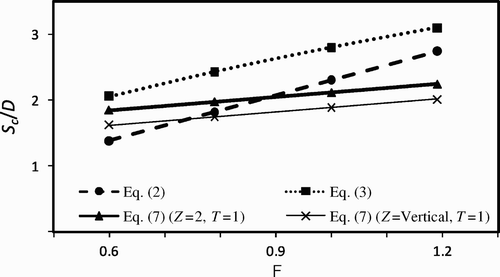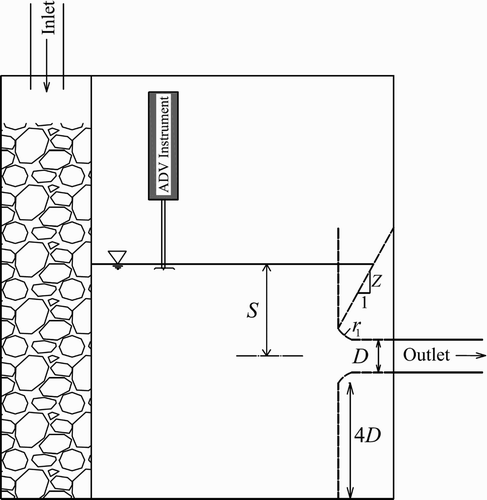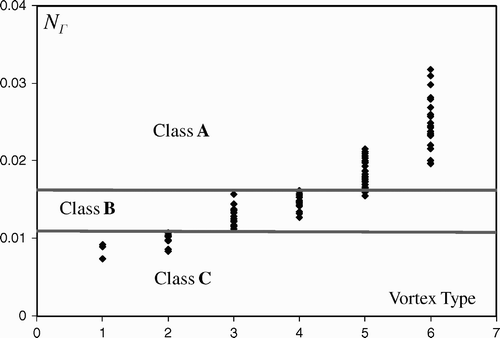Abstract
The effect of the intake head wall slope and the installation of a trash rack on the type and strength of vortices are studied experimentally. The strength within each vortex was determined by measuring its tangential velocity utilizing an Acoustic Doppler Velocimeter (ADV). Experiments were carried out with a projected intake and an intake with various head wall slopes, discharges and submerged depths. The results from the projected intake tests indicated that Type 6 vortex was present. However, the vortex strength and type reduced as the intake head wall slope increased up to the vertical position. In addition, increasing the intake head wall slope increased the vortex instability. All tests were repeated with a trash rack. A relationship was developed for vortex strength and the intake critical submerged depth based on the intake Froude number and the head wall slope. Moreover, a relationship has been found between vortex strength and type.
1 Introduction
Vortex formation at power intakes may occur at lower reservoir levels. The intake submerged depth and the geometry and layout of the intake have a direct effect on the vortex strength. Vortices can draw debris and air into an intake causing vibration and damage to turbines. Based on the visual classification of Alden Research Laboratory (), vortices can be divided into six types (Knauss Citation1987).
Figure 1 Types of vortices (Knauss Citation1987)

Vortex strength is evaluated by its circulation at the irrotational vortex region as
The critical submerged depth of air core vortices was found to vary with the intake Froude number F = V/(gD)1/2, where V is the average tunnel flow velocity, D tunnel diameter and g gravitational acceleration. The critical (subscript cr) submerged depth of air core vortices was described by Gordon (Citation1970)
A reduction in vortex strength in general means a lower critical submerged depth, i.e. as the vortex strength decreases, the safe operating submerged depth is reduced. Any disturbance or obstacle within a vortex increases internal friction and therefore reduces the vortex strength and S c /D. The proximity of, for example, an adjacent wall () reduces the vortex strength. In addition, a trash rack induces disturbances in the vortex path reducing its strength. Although these effects on the type and stability of vortices are known, no comprehensive study is as yet available. In the present study, tests were conducted on a projected intake as well as an intake with different head wall slopes 1 : Z () to investigate their effect on the type and strength of vortices. Relationships are also developed for vortex strength and critical submergence depth. In addition, a relationship is found between vortex strength and vortex type.
2 Dimensional analysis
Using the principles of the dimensional analysis, the relationship among parameters affecting the vortex circulation Γ can be expressed as (Anwar et al. Citation1978, Jain et al. Citation1978, Anwar and Amphlett Citation1980, Knauss Citation1987, Yildirim et al. Citation2009)
3 Experimental set-up
Froude similarity was considered as the basis of the model studies (Anwar et al. Citation1978, Hite and Mih Citation1994). As the diameter of typical power tunnels in medium and large dams is between 4 and 10 m, and usual tunnel flow velocities are between 4 and 10 m/s, for a usual model with scales between 1/30 and 1/60, the herein selected model tunnel diameter was 16 cm and discharge was between 0.015 and 0.030 m3/s. The intake had a rounded entrance radius of r = 0.15D (USBR 1974). Model observations indicated that asymmetric flow from the reservoir was necessary to form a stable Type 6 vortex in a wide range of flow conditions.
By studying the layout of typical existing dams, it became evident that the slope of the intake head wall varies between 2 : 1 to nearly vertical. Walls with Z = 2 : 1, 3 : 1, 4 : 1 and a vertical wall were installed () and vortex strength and type in each test determined and compared with the projected intake. The reservoir walls, the intake structure and the tunnel were made of Perspex. The side walls and the reservoir bottom were more than 4D away from the intake axis to eliminate effects on vortex formation (Anwar et al. Citation1978).
To avoid scale effects relative to viscosity and surface tension, minimum values proposed are R ≥ 5 × 104 (Daggett and Keulegan Citation1974), R ≥ 7.7 × 104 and W > 600 (Padmanabhan and Hecker Citation1984), R ≥ 1.1 × 105 and W > 720 (Odgaard Citation1986) and W > 120 (Jain et al. Citation1978). Minimum R and W values in the present work were 1.2 × 105 and 1.2 × 103, respectively, i.e. more than the above minimum values.
To study the effect of intake head wall slope on vortices, tests were first carried out with an intake projecting one diameter into the reservoir. By applying 4 different discharges and 3 different submergences, 12 Type 6 vortices formed at the intake and their strength was determined. Then, the effect of Z was investigated () for the same hydraulic conditions. Finally, a trash rack made of copper wire nets was installed at the intake face to study its effects on the vortex strength.
An electromagnetic flow meter installed in the closed piping system was employed to measure water discharge. The water surface elevation was measured by reading the scales marked on the reservoir wall. The tangential flow velocity of the vortices in the reservoir was measured by an ADV of 25 Hz. The correlation factor was above 0.8 in all tests. Measurements were conducted at more than D/2 distance from the vortex axis in the free vortex zone. To measure velocity at each point, data over some 20 s were collected and then averaged. Observations indicated that the proximity of the intake head wall to the location of the vortex caused vortex instability. In these conditions, measurements were made only if the vortex was steady.
4 Experimental results
4.1 Effect of intake head wall slope on vortex type
Measurements were conducted for four different values of F and S/D = 1.5, 1.75 and 2. All vortex types observed are listed in , indicating that as the slope of the intake head wall increases, the type of vortex reduces. Note that with a projected intake and for the same flow conditions as in , all vortices were of Type 6.
Table 1 Types of vortices for various flow conditions with different intake head wall slopes
4.2 Effect of intake head wall slope on vortex stability
Experiments indicated that vortices become unstable as the intake head wall slope increases toward the vertical position. To study vortex instability, additional tests with the lowest and highest F and 2 : 1 and vertical intake walls were conducted for three different S/D. In each experiment, the time percentage of vortex presence corresponding to the measurement time was recorded and referred to as the vortex stability. It was determined that at least 20 min of run time was required during each test to measure the vortex stability with confidence. Note that with the exposed intake and for identical flow conditions, all vortices were stable and of Type 6. Since vortices became unstable for steep walls and the vortex type under the unsteady condition was difficult to recognize, vortex Types 6 and 5 were classified together as Class A. Similarly, vortex Types 4 and 3 were classified as Class B () and weaker vortices 2 and 1 as Class C. Note that if R is large enough in a model and so scale effects remain insignificant, conditions leading to vortex Class A should be avoided. However, owing to scale effects and the possibility of the formation of weaker model vortices, vortices stronger than Class B (Type 3 or 4) are inacceptable.
Table 2 Vortex stability for various flow conditions and intake head wall slopes
As can be seen from and , the intake wall slope has a significant effect on reducing the type and stability of vortices, especially for lower F. For example, if F = 0.6, stable vortices of Type 6 were observed at the projected intake for all S/D, whereas with the vertical intake wall vortices were reduced to Class B with a stability of less than 5%.
4.3 Effect of trash rack
A trash rack disturbs the flow and can therefore reduce the strength and type of vortices. To study this effect, all the previous tests with various wall slopes, F and S/D were repeated to determine the vortex circulation with trash rack presence at the intake. Most prototype trash racks have an open area of 70–80%. A trash rack was therefore built with 75% opening with copper wires of 2 mm thick installed at the intake. A comparison of and shows that trash rack presence reduces the vortex strength, especially the stronger vortices.
Table 3 Vortex type with presence of trash rack
4.4 Calculating vortex strength and type
With over 100 tests of vortex strength for the variable S/D, F and Z, with and without trash rack presence, an equation was developed for NΓ with a correlation factor of 0.95 as
4.5 Calculating critical submergence depth
As shown in , a vortex stronger than or equal to Type 5 results in NΓ
> 0.016. Inserting into EquationEq. (6), the critical submerged depth then is
To check EquationEqs. (7) and Equation(8)
, additional data were collected for 10 various S/D for which the vortex type was measured in terms of F and Z. The submerged depth at which vortex Types 5 and 3 were formed was then compared with the predictions and the agreement was found to be good. Equation Equation(7)
for calculating the submerged depth of vortex Types 5 and 6 is also compared with the empirical EquationEqs (2)
and Equation(3)
in . The slope of the intake head wall is observed to affect the relationship between F and S
c
/D, an effect not considered in previous empirical equations.
Figure 4 Comparison of empirical EquationEqs (2) and Equation(3)
with EquationEq. (7)

5 Conclusions
Using physical model data, the effects of intake head wall slope and trash rack presence on the type and strength of intake vortices, as well as the critical submerged depth has been studied. The vortex strength was determined by measuring the tangential vortex velocity using ADV. The laboratory tests indicate that the intake head wall slope does affect the type and strength of the vortices, especially at lower Froude numbers F. In addition, it was demonstrated that as the intake head wall slope increases, vortices become more unstable. For example, for F = 0.6, stable vortices of Type 6 were always observed at the projected intake, whereas with the vertical intake head wall, vortices were reduced to Types 2 and 3. With trash rack presence, the vortex strength was further reduced, indicating a lower critical submergence depth. Equations among the circulation number, the vortex type and the remaining test parameters were developed. Finally, an equation for the critical intake submergence considering the intake head wall slope and trash rack presence is given. The slope of the intake head wall was demonstrated to affect these relationships significantly.
Notation
| D | = |
tunnel diameter |
| F | = |
Froude number |
| g | = |
gravitational acceleration |
| N Γ | = |
circulation number |
| r | = |
distance from vortex axis, radius |
| R | = |
Reynolds number |
| S | = |
submerged intake depth |
| S c | = |
critical submerged depth |
| T | = |
cross-sectional trash rack opening |
| V | = |
average tunnel flow velocity |
| v θ | = |
tangential velocity |
| W | = |
Weber number |
| Z | = |
intake head wall slope |
| Γ | = |
vortex circulation |
| υ | = |
kinematic fluid viscosity |
| ρ | = |
fluid density |
| σ | = |
surface tension of fluid |
Acknowledgements
All experiments were conducted at the Water Research Institute, affiliated to the Ministry of Energy, Tehran, Iran, whose cooperation is highly appreciated.
References
- Amphlett , M. B. 1976 . “ Air-entraining vortices at a horizontal intake. Report No. OD/7 ” . Wallingford, , UK : HRS .
- Anwar , H. O. and Amphlett , M. B. 1980 . Vortices at vertically inverted intake . J. Hydraulic Res. , 18 ( 2 ) : 123 – 134 .
- Anwar , H. O. , Weller , J. A. and Amphlett , M. B. 1978 . Similarity of free-vortex at horizontal intake . J. Hydraulic Res. , 16 ( 2 ) : 95 – 105 .
- Daggett , L. L. and Keulegan , G. H. 1974 . Similitude in free-surface vortex formation . J. Hydraulics Div. , 100 ( HY11 ) : 1565 – 1581 .
- Gordon , J. L. 1970 . Vortices at intake structures . Water Power , 22 ( 4 ) : 137 – 138 .
- Hite , J. E. and Mih , W. 1994 . Velocity of air-core vortices at hydraulic intakes . J. Hydraulic Eng. , 120 ( 3 ) : 284 – 297 .
- Jain , A. K , Ranga Raju , K. G. and Garde , R. J. 1978 . Vortex formation at vertical pipe intake . J. Hydraulic Eng. , 104 ( 10 ) : 1429 – 1445 .
- Knauss , J. 1987 . Swirling flow problems at intakes. IAHR Hydraulic Structures Manual 1 , 13 – 38 . Rotterdam, , The Netherlands : Balkema .
- Odgaard , J. A. 1986 . Free-surface air core vortex . J. Hydraulic Eng. , 112 ( 7 ) : 610 – 620 .
- Padmanabhan , M. and Hecker , G. E. 1984 . Scale effects in pump sump models . J. Hydraulic Eng. , 110 ( 11 ) : 1540 – 1556 .
- USBR . 1987 . Design of small dams , Washington, DC : U.S. Department of the Interior, Bureau of Reclamation .
- Yildirim , N. , Tastan , K. and Arslan , M. M. 2009 . Critical submergence for dual pipe intakes . J. Hydraulic Res. , 47 ( 2 ) : 242 – 249 .

